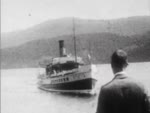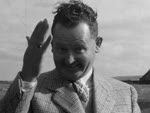EVACUATION OF ST. KILDA
Full length video
Please read Understanding catalogue records for help interpreting this information and Using footage for more information about accessing this film.
Title: EVACUATION OF ST. KILDA
Reference number: 0793
Date: 1930
Director: [filmed by John P. Ritchie]
Sound: silent
Original format: 16mm
Colour: bw
Fiction: non-fiction
Running time: 11.00 mins
Description:
The preparations and evacuation of the island of St. Kilda which lies 50 miles off the Western Isles. Dated 27th August 1930.
Filmed by John P. Ritchie, amateur cine enthusiast and ornithologist, during egg-collecting expedition to St. Kilda. This is unique footage of the preparations for evacuation, the existence of which was kept secret until 1979. At the time of the evacuation, Scottish Office regulations prohibited any photos or newsreel recordings of the event.
The motor boat seen towing rowing boat and being hoisted on board "Dunara Castle" was collected at Tarbert, Harris, on the outward voyage, to assist with the evacuation, there being no motorised boat on St. Kilda. N.B. The married women on St. Kilda all wore shawls. The film includes shots of Rachel MacDonald, whose child died for lack of medical attention, and thus contributed to the decision to evacuate St. Kilda.
See also refs 0418 and 0911
Shotlist:
No credits. Shot of St. Kilda from steamer as the "Dunara Castle" nears the island [fairly heavy scratches] (.08); Stac Lee and Boreray (.19); islanders row out to meet the "Dunara Castle" (.35); "Dunara Castle" is moored (.53); rowing boat goes ashore, below the island of Dun (.58); horned [white] sheep on the island. 667 of these sheep were gathered for transportation to Oban (1.07); A cleet (1.15); More sheep outside the church/manse with rowing boat coming ashore in the background (1.25); Brief shot of sheep and shepherd (1.27); Cottages in village street and two passengers from the ship (1.33); Two women and a child sitting outside a stone cottage with bundles on their knees, one spinning wool. A woman passenger looks on and examines the artricles for sale, gloves and socks knitted by the island women (1.57); an old woman knitting socks outside her cottage [photographer paid £2 for the privilege of taking this shot] (2.06); women and girls take fright and run away from the camera into their cottages (2.16); the rowing boat is loaded with sheep at the jetty. Shot of men and furniture on pier (2.44); the loaded rowing boat casts off and another comes in to take its place (2.56); shot from jetty of two sheep being pulled on ropes towards the loading point, motor boat passes behind (2.57); one rowing boat loaded with sheep is towed by motor boat to the "Dunara Castle" [the motor boat seen here and later being hoisted on board "Dunara Castle" was collected at Tarbert, Harris, on the outward journey, to assist with the evacuation as there was no motorised boat on St. Kilda] (3.09); women carrying bundles run into house to avoid camera (3.13); girl appears at the same door but shies off. Group of islanders outside house (3.14); women hide their faces from camera (3.16); old man smoking a pipe outside his house. A younger man picks up a stone to throw at the camera (3.22); Group of visitors outside the Post Office (3.31); woman walks towards the camera carrying a large bundle of material possibly tweed, deliberately tries to walk out of shot, row of cottages in the background (3.42); girl walks away calling to a dog (3.44); group of people outside house. A man from the mainland distributes sweets to children and adults. Women turn away from camera and run off quickly when the sweets are finished (4.08); Cockerel on path (4.14); woman walks away to hide behind a bale of tweed. Another collects a glass of water from a bucket, walks past gable end of house and into the doorway of an 1830-style house, comes out again and into an 1860-style house (4.42); another woman runs away from the camera (4.45); two old women sitting outside, one covers her face with her shawl (4.52); cattle grazing in front of the houses (5.04); shot of John Ritchie, the film-maker, as he climbs part of the way up a rock face with a haversack, motions with his hand as though collecting birds' eggs at the top, and then climbs down again (6.03); guillemots on cliff (6.11); gannets nesting. Two birds land beside a nest which contains one egg (6.39); shots of kittiwakes and guillemots at nests, kittiwakes flying, landing by nests [almost certainly not filmed on St. Kilda if John Ritchie was confined to Hirta during his visit] (6.56); visitors and islanders board the "Dunara Castle". Shot of a lifeboat marked "Glasgow" (7.18); shot of tree-lined coast from boat - not on St. Kilda (7.26); Gulls. Shots of gulls in the air and on land (7.41); Shots of eggs in nest (7.47); Last look at St. Kilda, the lonely Western Isle (7.55) The motorboat pulls alongside the "Dunara Castle" and is hoisted aboard (8.17); Four men and a dog on deck with shots of an island - not St. Kilda, in the background (8.21)
N.B. The married women on St. Kilda all wore shawls. The film includes shots of Rachel MacDonald, whose child died for lack of medical attention, and thus contributed to the decision to evacuate St. Kilda.






